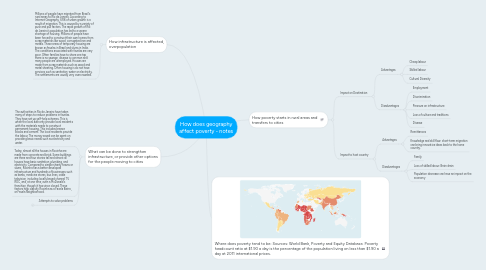
1. How infrastructure is affected, overpopulation
1.1. Millions of people have migrated from Brazil's rural areas to Rio de Janeiro. According to Internet Geography, 65% of urban growth is a result of migration. This is caused by a variety of push and pull factors. The rapid growth of Rio de Janeiro's population has led to a severe shortage of housing. Millions of people have been forced to construct their own homes from scrap materials like wood, corrugated iron and metals. These areas of temporary housing are known as favelas in Brazil and slums in India. The conditions associated with favelas are very poor. Often families have to share one tap, there is no sewage, disease is common and many people are unemployed. Houses are made from scrap materials such as wood and metal sheeting. Often housing is do not have services such as sanitation, water or electricity. The settlements are usually very overcrowded.
2. What can be done to strengthen infrastructure, or provide other options for the people moving to cities
2.1. The authorities in Rio de Janeiro have taken many of steps to reduce problems in favelas. They have set up self-help schemes. This is when the local authority provide local residents with the materials needs to construct permanent housing. This includes breeze blocks and cement. The local residents provide the labour. The money saved can be spent on providing basic needs such as electricity and water.
2.2. Today, almost all the houses in Rocinha are made from concrete and brick. Some buildings are three and four stories tall and almost all houses have basic sanitation, plumbing, and electricity. Compared to simple shanty towns or slums, Rocinha has a better developed infrastructure and hundreds of businesses such as banks, medicine stores, bus lines, cable television, including locally based channel TV ROC, and, at one time, even a McDonald's franchise, though it has since closed. These factors help classify Rocinha as a Favela Bairro, or Favela Neighborhood.
2.3. Attempts to solve problems
2.3.1. 1. Clearance of the slums: In the past the authorities tried to clear the slums - people just moved elsewhere.
2.3.2. 2. Site and service schemes: These are schemes whereby the government will provide a site (a small concrete ‘hut’) and basic amenities such as water and sewer facilities. The migrant is given rights of ownership and then expected to complete the work at his or her expense. This is often done as a cooperative between groups of migrants. In other situations, the authorities just provide the plot and building materials for the migrants to construct their own homes.
2.3.3. These schemes are relatively cheap and give the migrants a sense of control over their future. They also encourage community spirit.
2.3.4. 3. Rehabilitation (Multiroes self-help schemes): An alternative to this scheme is to provide the residents of the shanty towns with the materials to improve their existing shelters. Residents are also encouraged to set up community schemes to improve education and medical services. Residents may also be given rights of ownership whilst local authorities come in and provide electricity, water and sewerage disposal. e.g. Favella Monte Azul
2.3.5. It is a cheaper option than the site and service schemes but simply hides the real problems. The germs may not have been removed, the land still unsuitable and the water/sewer system still not adequate.
2.3.6. 4. Housing developments: Large areas of shanty towns were cleared, tower blocks built and the shanty town residents re-housed. e.g. Cingapura Housing Project
2.3.7. 5. Charities: charity projects provide jobs and other benefits such as pensions and medical care. e.g. Focolare Movement
2.3.8. 6. Transport: Transport - underground metro system - improves movement of people and reduces pollution, new roads, new train and bus services, pedestrianised CBD and parking restrictions.
2.3.9. 7. Industrial estates: New industrial estates with water, sewerage and electricity are located close to the favelas to provide business premises and jobs
3. How poverty starts in rural areas and transfers to cities
3.1. Impact on Destination
3.1.1. Advantages
3.1.1.1. Cheap labour
3.1.1.2. Skilled labour
3.1.1.3. Cultural Diversity
3.1.2. Disadvantages
3.1.2.1. Employment
3.1.2.2. Discrimination
3.1.2.3. Pressure on infrastructure
3.1.2.4. Loss of culture and traditions
3.1.2.5. Disease
3.2. Impact to host country
3.2.1. Advantages
3.2.1.1. Remittances
3.2.1.2. Knowledge and skill flow: short-term migration can bring innovative ideas back to the home country.
3.2.2. Disadvantages
3.2.2.1. Family
3.2.2.2. Loss of skilled labour: Brain drain
3.2.2.3. Population decrease can have an impact on the economy

